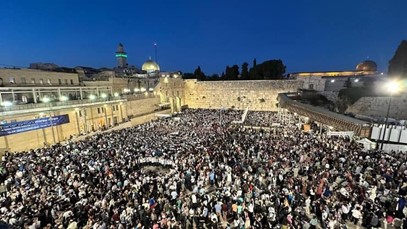The Sounds of Yom Kippur: The Prayer that will be Heard Forever
I have no idea what will happen to us in another day against Iran, if Dizengoff Square will stand in 100 years, but in 1,000 and 2,000 years and no matter what happens – on the eve of Yom Kippur after sunset, Jews will stand and pray “Kol Nidrei”
By: Shoshana Chen (first published in Hebrew in “Yediot Achronot,” chief editor Avi Meshulam, on Yom Kippur eve 5785/2024)
Until the end of his life, Shimon Peres preserved the memory of the “Kol Nidrei” prayer in his hometown, where most of its Jews were murdered in the Holocaust: his grandfather, may G-d avenge his blood, passed in front of the ark, and himself, as a sheltered child, eagerly absorbed the excitement of the day’s prayers under the warmth of his grandfather’s large tallis (prayershawl).
At the funeral of Peres, according to his will, the chilling “Avinu Malkeinu” (Our Father our King) prayer was sung, which on this Yom Kippur, which falls on Shabbat, will only be said once, at the “Neila” service, and whose words tear and cut this year more than every other year: “Our Father our King, let this hour be an hour of mercy and a time of desire before You. Have mercy on us and our wrongdoers, we will avenge the blood of Your servants, have mercy and forgive us because we have no deeds, do us righteousness and mercy and save us.” Just like our ancestors cried out, and the ancestors of ancestors further and further back. How many Jewish children do not know this prayer? And why?
On the eve of Yom Kippur, in Hadera, a young man who studied in a Kollel was slaughtered, a charedi (ultra-Orthodox) father of six. In the morning of that day, a Hezbollah missile barrage on Kiryat Shmona killed two young men who went for a walk with their dogs in the city, and in Lebanon, a reservist who emigrated from France was killed. All because they were Jewish. A year passed, even those who tried to suppress their Judaism received bloody reminders and torture.

The Kotel (Western Wall)
On the night of Yom Kippur, my mother’s barrack mates, lying on the bunks in Auschwitz, thirstily drank up the words of “Kol Nidrei” that she had memorized. No one blamed her for her religion. They all knew the text. The five prayers of the day were prayed in the cellars in Spain in a whisper against the terror of the Inquisition and they felt the strengths that the prayers of the day pour into their veins. The melody of “Kol Nidrei” was composed at that time.
The prayers in the streets of Tel Aviv or Ramat Hasharon are intended for those who are not regular worshipers in the various synagogues. who do not know how to follow the machzor (prayerbook), when to turn the page, when to get up, when to sit down. What text to say once and what three or even seven times. What is the relationship is with the prayer leader? And how do you behave in the chilling prayer of confession that is said ten times during the day? And they only want to taste the flavour which their ancestors have sipped generation after generation.
Why not devote to prayer, to the experience, and to finding within it a pinch of the energy that we devote to the recipe for the honey cake or the kneidlach?
Especially in the last year when the words jump out of the machzor. In the prayer “U’Netaneh Tokef”, that is also said on Yom Kippur: “Who will live and who will die, who by water, who by fire, who will be by the sword, who by hunger, who by thirst, who by suffocation, who by torment, who will be humbled and who will be exalted.” Every word hits like a hammer.
There are plenty of synagogues where even those who haven’t browsed the machzor can have a pleasant experience. Ones where the experience can be passed on to children who have never heard a prayer. And they will have a take away from their people for the rest of their lives.
“When I visited Israel in my youth, there was a wonderful rabbi from Beitar who invited me to spend the Sabbath with his family,” said Pierre Poilievre, candidate for Prime Minister of Canada, in an emotional speech. “I was impressed by the fact that over 2,000 years ago, on the same land, the same people sang the same songs. The Jewish people are the only people I know that in the same language on the same land prayed from the same faith as thousands of years ago.”
I have no idea what will happen to us in another day against Iran, if Dizengoff Square will stand in 100 years, but in 1,000 and 2,000 years and no matter what happens – on the eve of Yom Kippur after sunset, Jews will stand and pray “Kol Nidrei,” and as the day ends, before the stars come out, at the “Neila” service, they will yell out “Shema Yisrael” (Hear Oh Israel) – the prayer that came out the mouths of quite a few residents of the Otef (Gaza Envelope), the Ofakim and Netivot settlements who wanted to make sure that the IDF soldiers would not accidentally shoot them. Even in 1,000 years, the “Neila” prayer will end with the blowing of the shofar and with hope.
Gmar chatima tova












